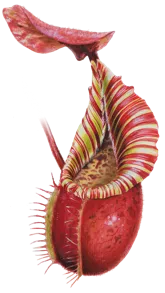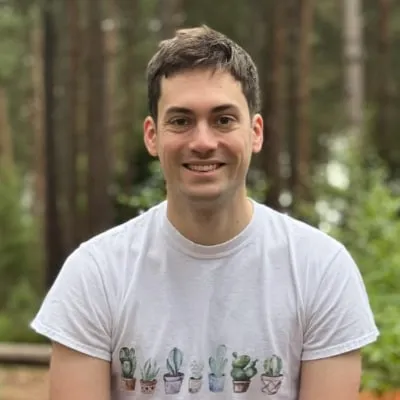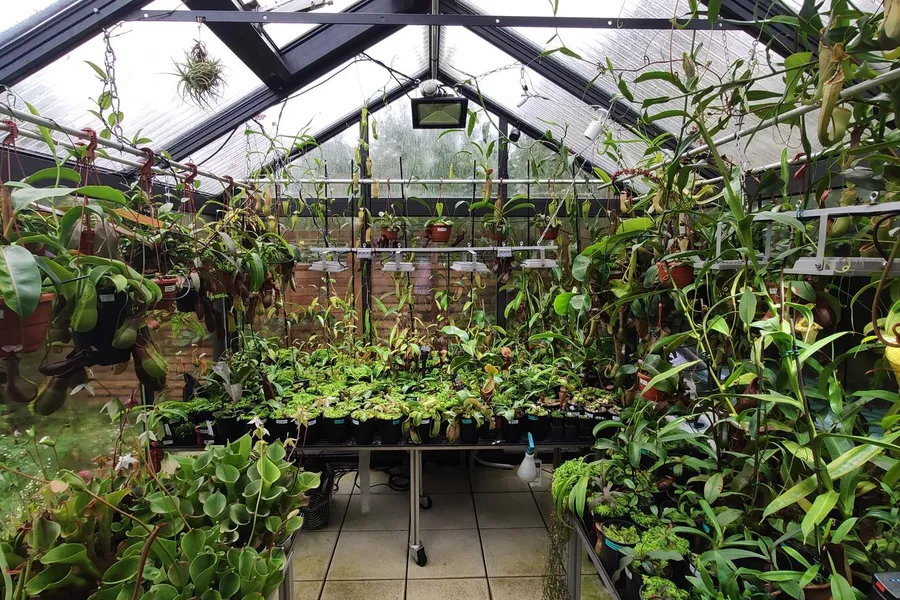Today I’ve got a great Q&A for you! German carnivorous plant grower Joachim Danz was kind enough to answer some of my questions on his fantastic CP collection and greenhouse. Joachim is a moderator of the Gesellschaft für Fleischfressende Pflanzen (GFP) forum and is active in various CP-focused Facebook groups. After seeing photos of his very impressive greenhouse, I was keen to learn more about his growing setup and so invited him here on the blog.
Be sure to subscribe to Tom’s Carnivores for more articles like this.
Thanks again for reading, and enjoy!
TB: Firstly, how did you first get into the carnivorous plant hobby?
JD: As a child I was interested in electronics, and after spending a lot of my time building circuits I expanded my knowledge and projects from amateur radio into radio frequency engineering. It was obvious to me that I had to study electronics / telecommunications engineering, and after many years at university I finally joined the Test & Measurement company I had dreamed of as teenager here in Munich. I started as development engineer over twenty years ago and today I’m still in the same department loving my interesting job. 🙂
Once my hobby had become my daily work, I started to focus on my other interests in my spare time. By chance I bought a strange plant - a Nepenthes - in a local garden center as gift for a friend. Giving it away was a dumb move, obviously, and I decided I had to get one for myself too! From there it really started: after reading everything about Nepenthes on the internet (this was quite possible in 1998!) I bought a Nepenthes starter set with five plants from a guy who lived only few kilometers away called Andreas Wistuba. He already had a very nice selection of plants on his list.
I also discovered the “Gesellschaft für Fleischfressende Pflanzen”, the AUCPS, and the ICPS. I joined the same year to get more information about the plants and also to contact with other growers. Somehow I lost the last two memberships, but I am still member of the GFP. The GFP also runs the last really active Internet forum (maybe I am a bit biased being one of the moderators): https://forum.carnivoren.org/forums/
From 2002 onwards I also had a simple web page called “Nepenthes in cultivation”, showing some pictures of my plants and my setup with some tips on cultivation. It is still always fun, when someone remembers my site being shut down many years ago:
Click on any photo to zoom in. Use arrow keys or swipe to navigate.
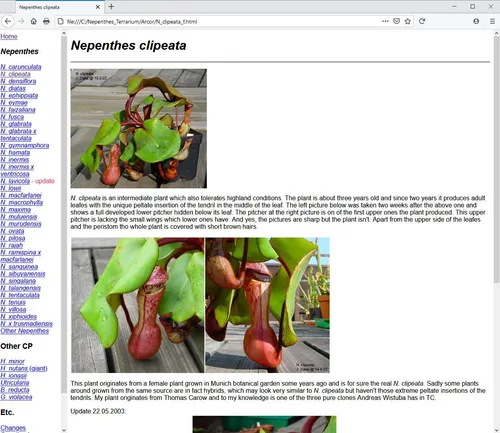 Joachim's original website, article on N. clipeata
Joachim's original website, article on N. clipeata 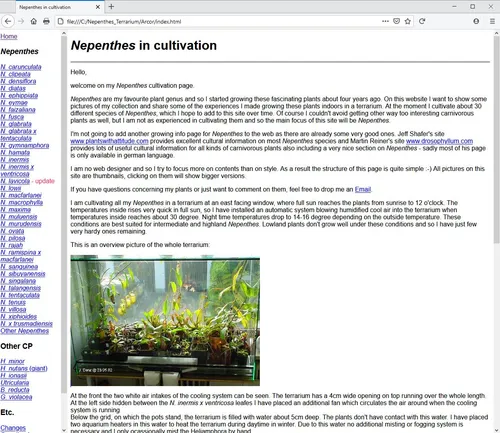 Joachim's original website
Joachim's original website With a shift towards Facebook nearly all CP related forums have in fact ended operation and it took me some time to join as well. It is the only way to see what is going on internationally right now. From time to time I also share some pics of my setup and my plants, although they vanish into the Facebook history quite fast. So I place most of these pictures with additional information in my Greenhouse thread at the GFP-Forum, where they are easier to find.
Before building your greenhouse in 2017, where did you grow your carnivores? Which genera did you grow?
My first setup consisted of a small aquarium which held my first five plants. This soon evolved into a larger aquarium (100 x 40cm growing area). At that time the plants were growing in the aquarium on a windowsill without any further technical assistance.
Living in Germany made it easy to get very well-grown new plants in local garden centers and building supplies stores, as Thomas Carow supplies them from his nursery. I still remember the N. veitchii from Thomas I got in such a store. Soon, of course, it outgrew my terrarium and I swapped the plant with Christian Klein.
Click on any photo to zoom in. Use arrow keys or swipe to navigate.
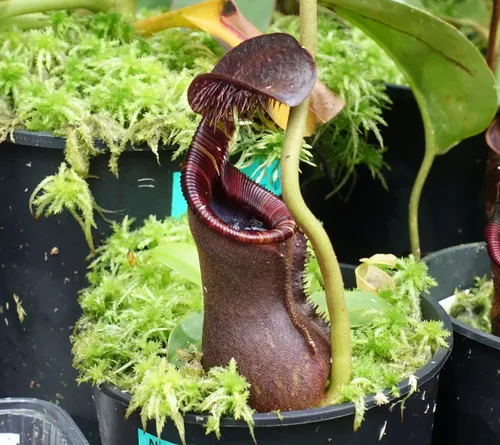 Nepenthes lowii Trusmadi
Nepenthes lowii Trusmadi 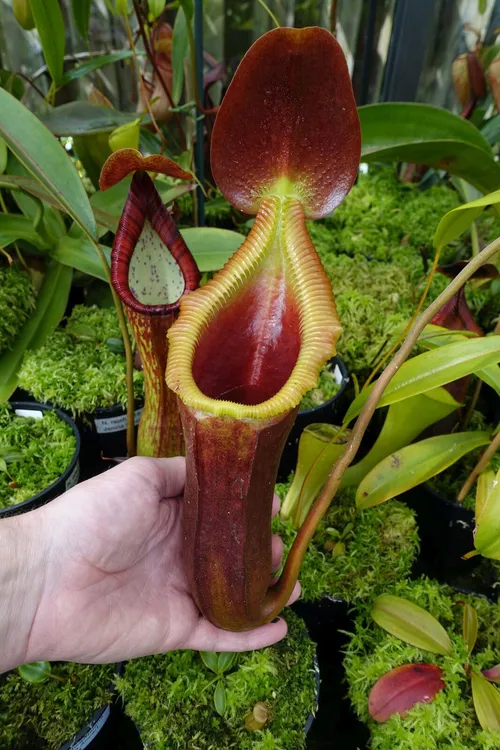 Nepenthes x Trusmadiensis
Nepenthes x Trusmadiensis After moving to Munich in 2000 I soon had to get a larger growing space for my Nepenthes and I bought the biggest terrarium I could fit into my car. 120 _ 60 _ 80cm was a good size for the expanded windowsill. I added two Metal Halide lamps and an air humidifier, which turned on at a set temperature blowing humidified air from my living room into the terrarium on hot days. This helped growing Nepenthes in summer, and thanks to the lights also during the shorter light periods in winter. Sadly Nepenthes get more picky when getting older and larger and this limited the plants which grew really well in my living room.
The more robust Sarracenia are easy to grow outside here in Germany and so I always had a smaller selection of plants on my balcony and now in the garden. Sadly my favorites, S. leucophylla, are not particularly cold resistant during winter and won’t survive the colder winters we have here every few years. I still grow my first S. flava I got in 1998 and have shared this robust clone to many other local growers.
What prompted you to undertake your greenhouse project? Can you give a summary of the build?
Being new in Munich I got in contact with some local growers and was very impressed by the greenhouses of two good friends: Stefan Ippenberger is specialized in winter-growing Drosera and Klaus Keller already had a Nepenthes greenhouse with totally amazing plants! Seeing their plants set my mind onto how I could best grow Nepenthes.
Sadly the disadvantage of having a dream job in Munich is living in Munich, making it painful to get an appropriate space for a greenhouse. Long story short, in spring 2017 the greenhouse project started.
Click on any photo to zoom in. Use arrow keys or swipe to navigate.
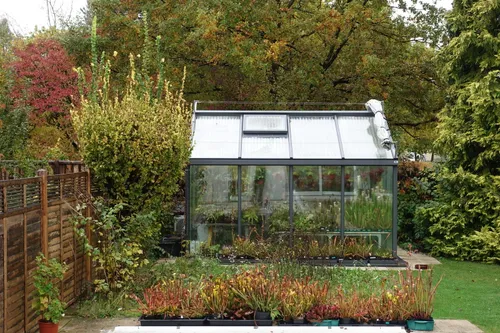 Sarracenia in the foreground ready for fall. Shade cloth moved to the side for winter
Sarracenia in the foreground ready for fall. Shade cloth moved to the side for winter .ejG_NU3L_1dkUEt.webp) Shade cloth with some distance to the roof during summer (April to October)
Shade cloth with some distance to the roof during summer (April to October) Winters are quite cold here in Bavaria with temperatures occasionally down to -20°C (-4°F). Therefore the greenhouse had to have good isolation with thermally-isolated profiles and also the ring foundation needed to be well-insulated. As we can see the greenhouse from our living room, I wanted something which looked more like a conservatory than a typical greenhouse. With a side-height of 2m it is quite large, and through the insulated glass we can see the plants from the outside - and my wife can see in too, where I spend some hours at the evenings and weekends. The roof is built out of Alltop-plexiglass, transparent for UV light.
The base is only a ring about 70cm deep, isolated from the outside. This open structure allows excess water to drain away and helps to cool during summer and getting some warmth during winter from the ground.
I believe you’ve since installed a heat pump and external shading, is that right? How effective have you found these at maintaining conditions in winter and summer?
In the first year I had the shading inside the greenhouse and was getting quite high temperatures during sunny days - even though both windows in the roof open automatically. To get better air-flow, a modified window-opener now additionally opens the greenhouse door during hot weather. In the second year I installed shading about 30cm above the roof, which now keeps the temperatures inside slightly lower. This year an additional temperature-controlled air humidifier helps to lower temperatures further (about 3-4°C) and help air circulation. This helps the more sensitive Nepenthes to pitcher during summer, although some do still stop the pitcher production.
Heating was initially done with two electrical greenhouse heaters set to 8°C (46°F) minimum during winter. Keeping an eye on the electric bill, daytime temperatures remained at this 8°C minimum for the two to three coldest months of winter. The Nepenthes of course stopped growing and a few - like N. veitchii - did not survive this treatment.
Being aware of possible heater failures it was very important to install a remote temperature-monitoring system with alarms in our house and also on my mobile phone - and it turned out to be the best idea, having saved my plants more than once during failures or when heaters were set too low. In case electricity fails, I have a 4kW gas heater to bridge the gap until the heating problem is repaired. This gas heater has to be started manually, because the standby uses too much gas over time and all others I found need electricity to start the flames. So I have to react fast, if the alarm turns on!
Click on any photo to zoom in. Use arrow keys or swipe to navigate.
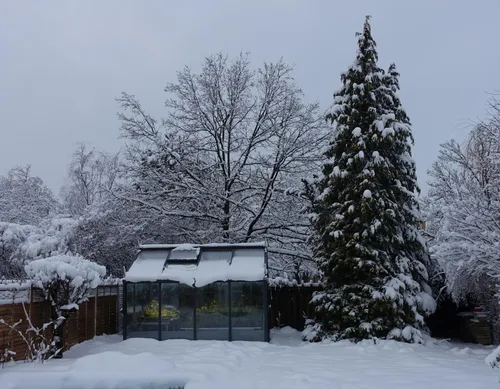 01. The greenhouse in winter
01. The greenhouse in winter 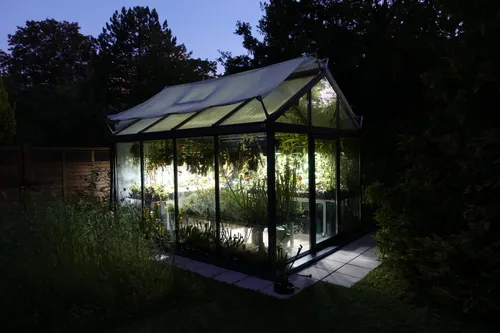 02. Greenhouse by night
02. Greenhouse by night 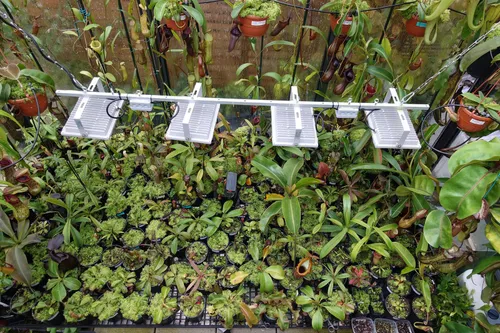 03. Nepenthes under lights
03. Nepenthes under lights 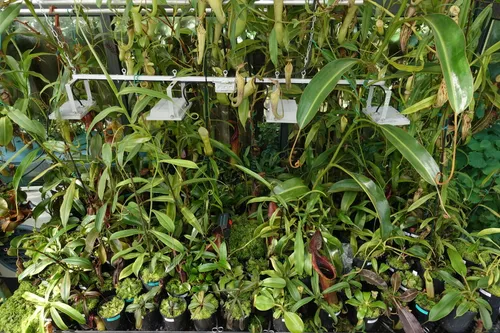 04. Nepenthes under lights
04. Nepenthes under lights .%20The%20hanging%20piece%20of%20plastic%20in%20front%20is%20to%20see%20if%20an%20electrical%20fan%20is%20operating%20(clima_%20heater%20or%20Honeywell%20CL48PM%20humidifier).B6NvhkXh_ZGePXL.webp) 05. Fallback heater on the left (Joachim has two of these). The hanging piece of plastic in front is to see if an electrical fan is operating (clima, heater or Honeywell CL48PM humidifier)
05. Fallback heater on the left (Joachim has two of these). The hanging piece of plastic in front is to see if an electrical fan is operating (clima, heater or Honeywell CL48PM humidifier) 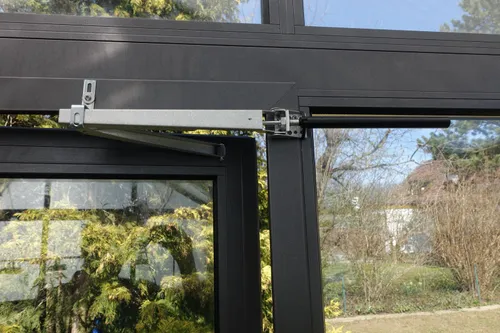 06. Automatic window opener
06. Automatic window opener Three months without any growth activity was way too long for me, and so last year I installed a heat pump. The heat pump is in fact a split air conditioner generating four parts of heat energy out of one part electrical energy (depending on outside temperature of course). With a simple control built using cheap WiFi sensors and switches the temperature is now around 20°C from 8am to 8pm and the minimum night temperature is set to 8°C, with a hysteresis of about 5°C. My setup uses Sonoff-switches with the ewelink-App.
With the added 100W LED outdoor spotlights the day-length is increased to 13h and so the plants can grow year round. It is very nice to enter the warm greenhouse in the evening hours during winter to watch how they grow.
And you’ve added a webcam-based monitoring system too, right? What other equipment is hooked up to WiFi for remote control?
Yes - to leave the greenhouse alone for days at a time the watering system is automated with one Gardena OS90 square-sprinkler per table and some mirco-drip parts for the hanging baskets. A good pump is hooked to a rainwater-reservoir inside the greenhouse and the pump is operated for one minute in the afternoon and one minute in the morning on hot days. The pump is controlled by a WiFi-socket allowing me to add multiple operating times. I can control this from my mobile wherever I have internet available.
Click on any photo to zoom in. Use arrow keys or swipe to navigate.
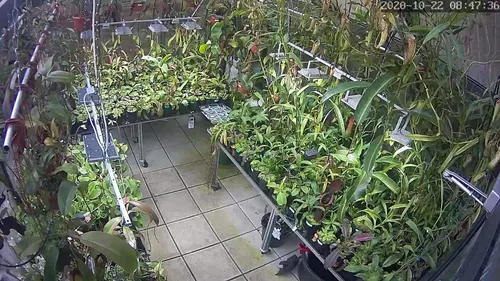 Jungle webcam 1
Jungle webcam 1 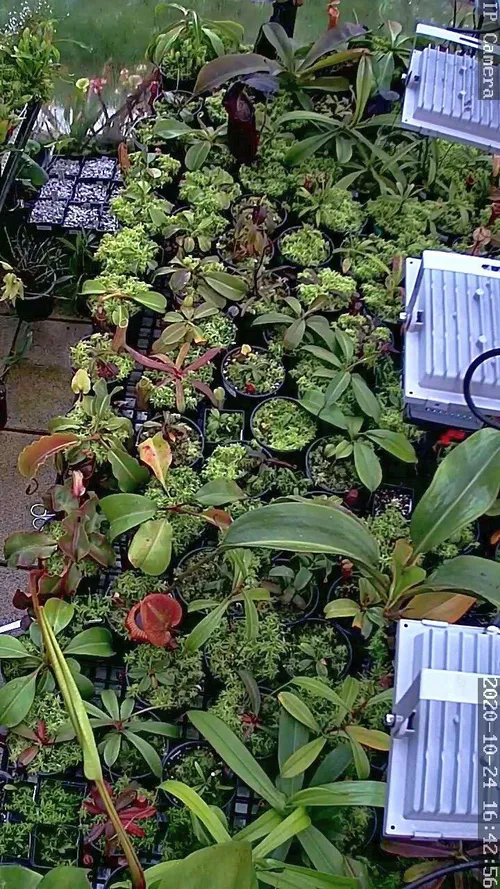 Jungle webcam 2
Jungle webcam 2 I think one of Murphy’s Laws states that something will fail the day after you leave and your plants won’t survive. To overcome this problem three webcams are installed inside the greenhouse and I am able to watch the plants whenever I want. In fact this system saved some of my plants last year: I realized while 800km away that one sprinkler was stuck and two thirds of one table didn’t get any water. Luckily I could switch the pump on and off with the remote WiFi socket, and after a few attempts the sprinkler decided to start working again. Phew!
Of course I know some people nearby, who can help in such a situation - but first I have to notice the problem and ask for their support!
And as second plus of this system, I also got my first cat video! The alarm system took this video in the middle of a hot summer night, when the door was open all night and a cat entered the greenhouse to inspect my plants. 🙂
I know you grow Sarracenia and other temperate genera too. Do any of these grow alongside your Nepenthes?
Being fascinated by carnivorous plants I grow different species outside and inside the greenhouse. The more robust Sarracenia grow outside in water trays year round, but more sensitive species like Cephalotus, Darlingtonia, Dionaea and the southern Sarracenia are only outside from spring to fall and spend the colder winter in the Greenhouse below the tables. Heliamphora, large-leafed Utricularia from the Orchioides-section and some other companion plants like similar conditions to Nepenthes, and these grow alongside them year round.
Click on any photo to zoom in. Use arrow keys or swipe to navigate.
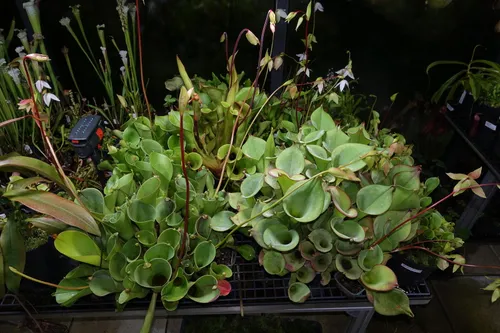 01. Heliamphora
01. Heliamphora 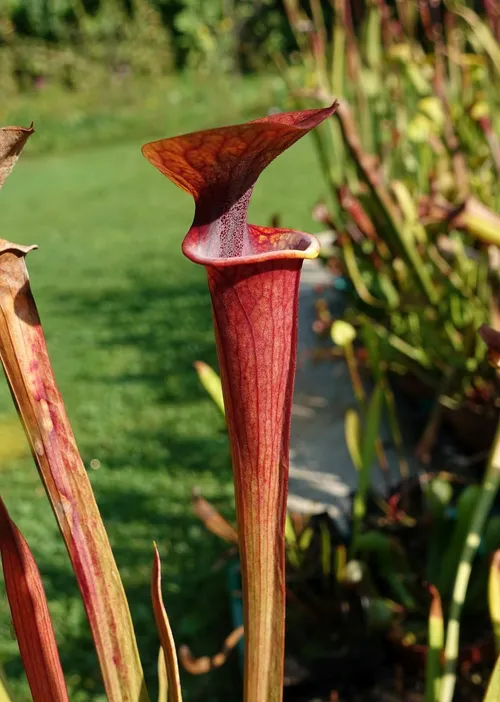 02. Sarracenia flava
02. Sarracenia flava 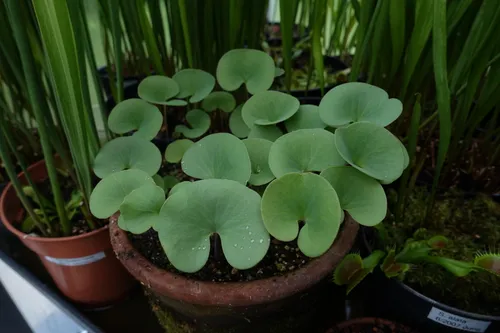 03. Utricularia reniformis large
03. Utricularia reniformis large 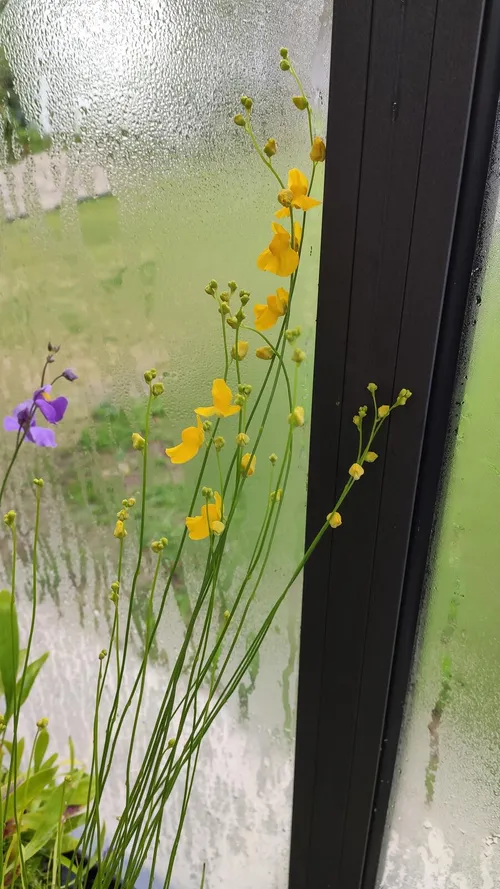 04. Utricularia praelonga in flower
04. Utricularia praelonga in flower 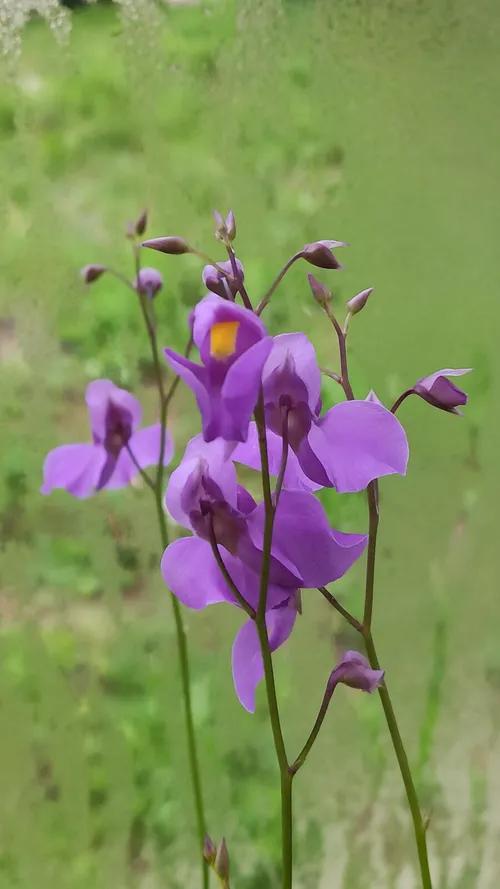 05. Utricularia longifolia flower
05. Utricularia longifolia flower 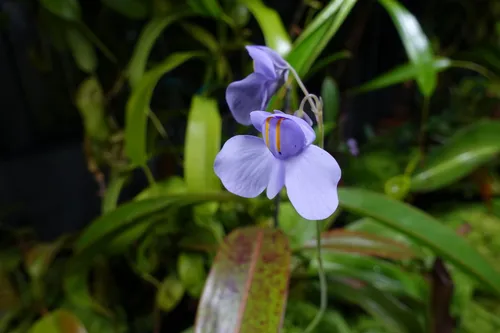 06. Utricularia nelumbifolia
06. Utricularia nelumbifolia 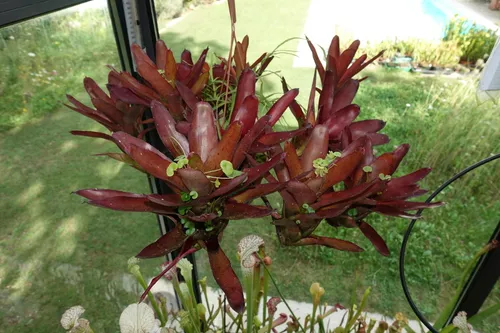 07. Neoregelia camorimiana with Ut. nelumbifolia seedlings
07. Neoregelia camorimiana with Ut. nelumbifolia seedlings 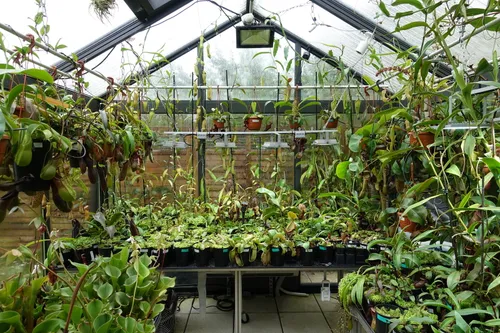 08. Various genera
08. Various genera Sarracenia leucophylla is among my favorite plants other than Nepenthes and they really need longer, warmer summers than we have here in southern Germany. So I placed them on one of the Tables in the sunniest and warmest spot of the greenhouse. Their growth season is now much longer and so they fare much better, developing impressive fall pitchers that I never saw while they were outside. They were not close to the lights last year and they entered dormancy as normal. The two newly-added lights are much closer now and so I might have to put them below the tables at the end of the year to force them into dormancy.
Moving onto your Nepenthes - how large is your collection today, and do you have a particular focus?
To stay organized I have an Excel sheet with details of all plants I grow. It contains the following information:
- the latin name of the plant
- the location it originates from
- clone-number
- the sex of the plant
- the person I got it from
- when I got it
- additional comments, for example who is waiting for a cutting.
This list says that I grow 247 Nepenthes as of today.
I have lots of smaller plants so this amount is not really a problem. Of course when they all get larger I have to decide which ones to keep. From some species I have more than one plant, so this makes it easier to give one away - although I’ve realized that Nepenthes are difficult to separate from one another once they’ve grown into a jungle together. Luckily Nepenthes start to make basals when larger and then it is easy to make cuttings out of the climbing stem bringing them to a smaller size again.
My main focus lies on pure highland species - real lowlanders won’t flourish in the conditions in the greenhouse. With the space I gained with the greenhouse I am more open also to hybrids now, but only simple crosses with distinctive features: I grow some N. lowii and N. clipeata hybrids, and of course also those hybrids I got as pure species and which turned out to be something different.
Click on any photo to zoom in. Use arrow keys or swipe to navigate.
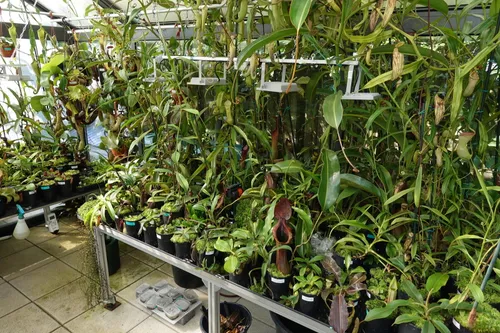 01. The jungle!
01. The jungle! 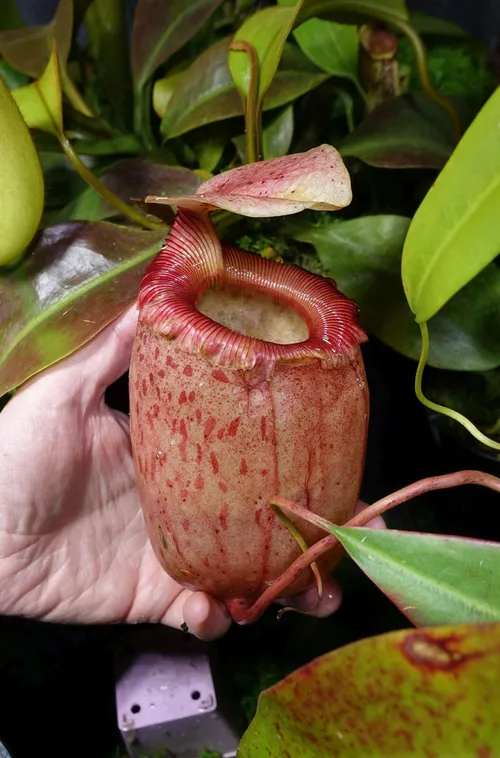 02. Nepenthes sibuyanensis
02. Nepenthes sibuyanensis 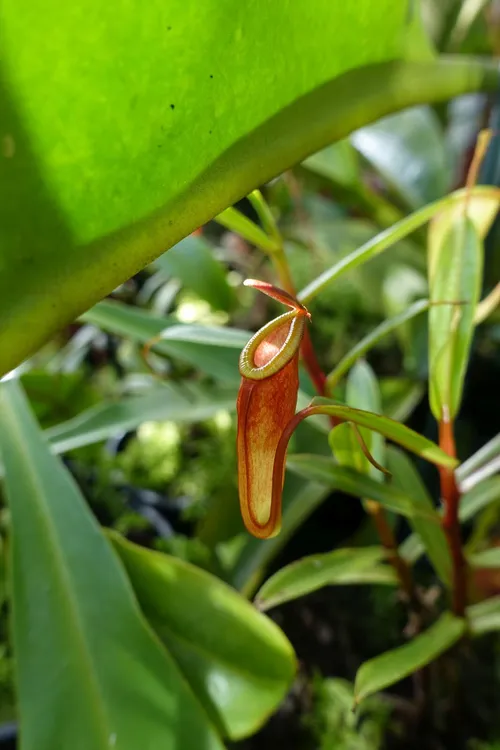 03. Nepenthes dubia from Malea
03. Nepenthes dubia from Malea 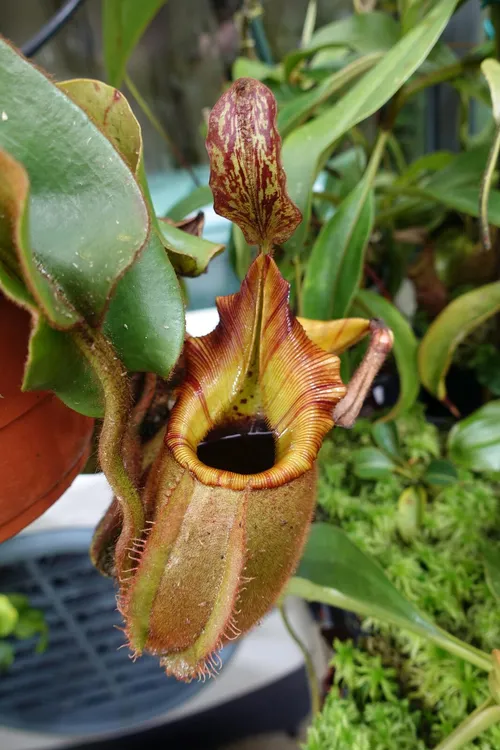 04. Nepenthes veitchii
04. Nepenthes veitchii 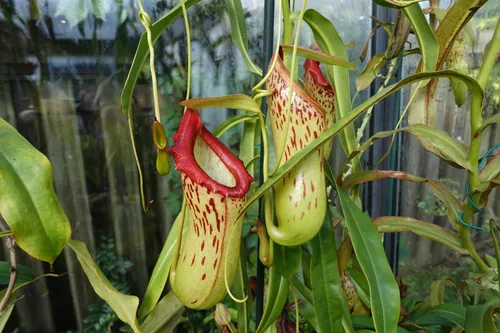 05. Nepenthes burkei
05. Nepenthes burkei 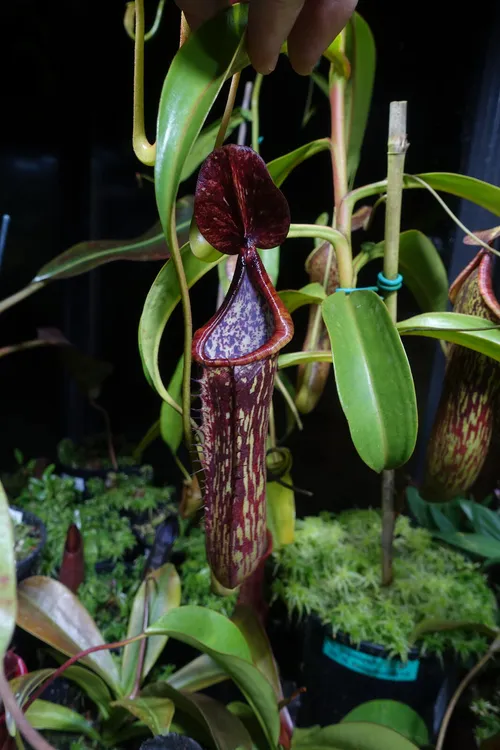 06. Nepenthes copelandii
06. Nepenthes copelandii 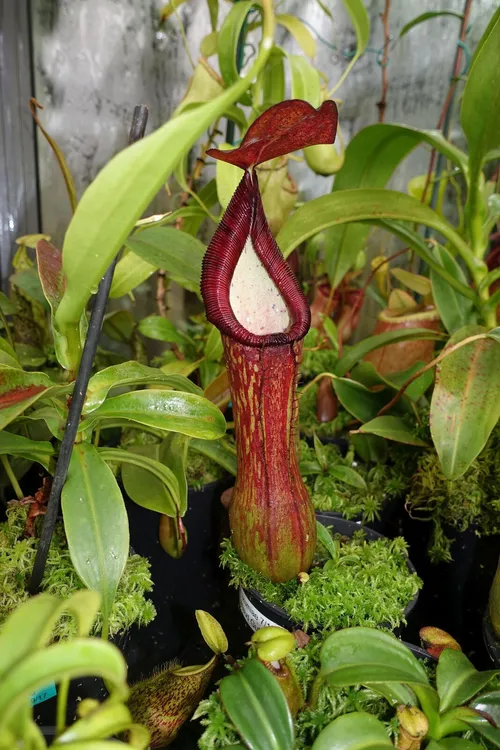 07. Nepenthes pulchra
07. Nepenthes pulchra 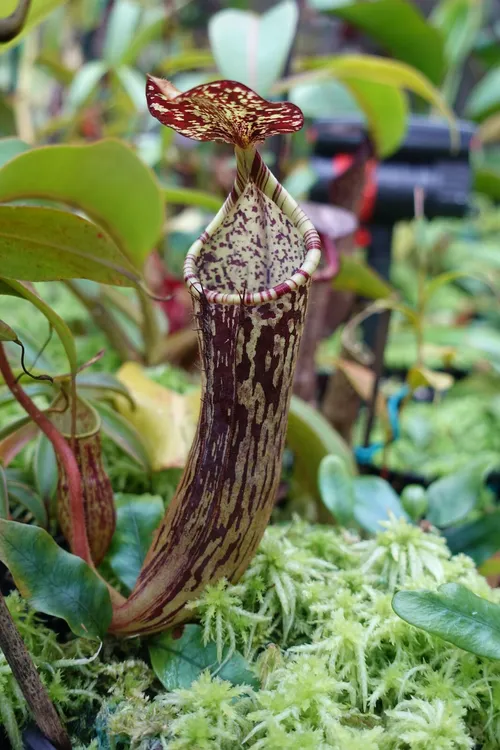 08. Nepenthes stenophylla
08. Nepenthes stenophylla 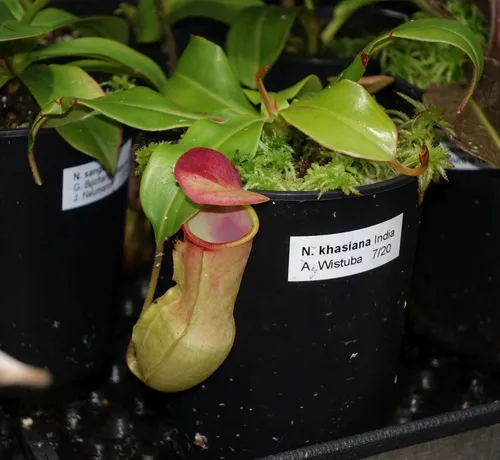 09. Nepenthes khasiana
09. Nepenthes khasiana 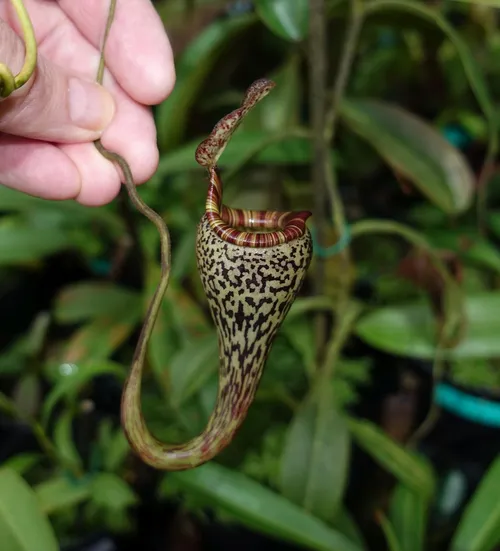 10. Nepenthes vogelii, type specimen
10. Nepenthes vogelii, type specimen 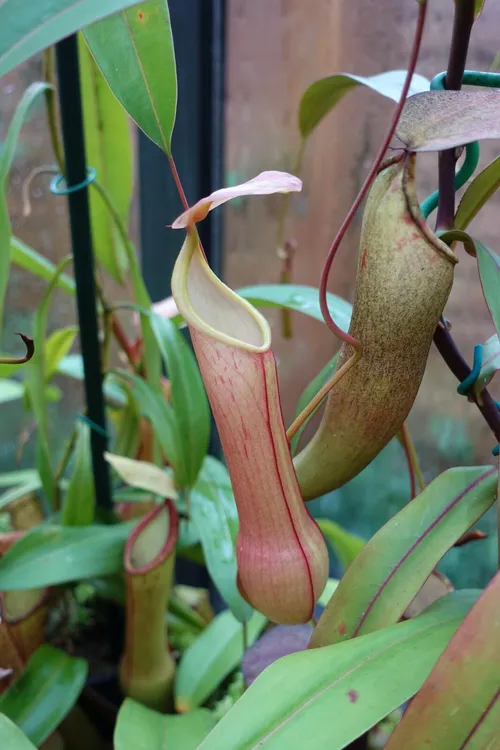 11. Nepenthes graciliflora
11. Nepenthes graciliflora .DbwPCQaC_2oIxlY.webp) 12. Nepenthes naga (or N. naga x bongso)
12. Nepenthes naga (or N. naga x bongso) 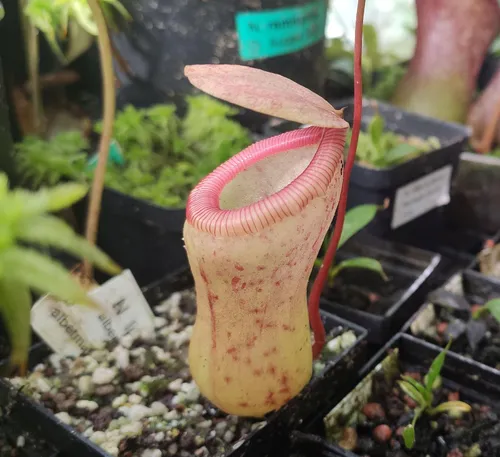 13. Nepenthes ventricosa
13. Nepenthes ventricosa 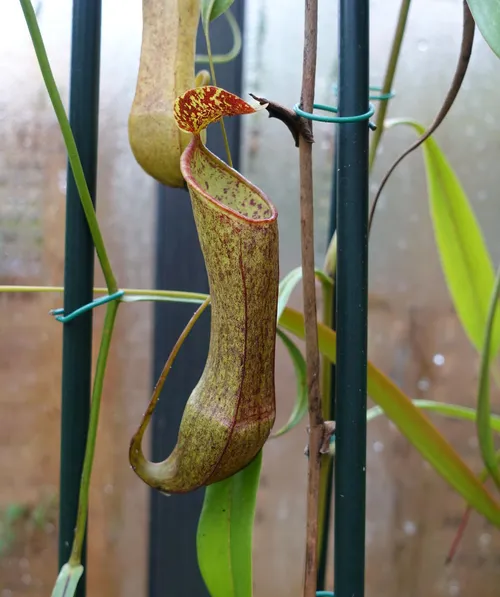 14. Nepenthes tobaica, female
14. Nepenthes tobaica, female 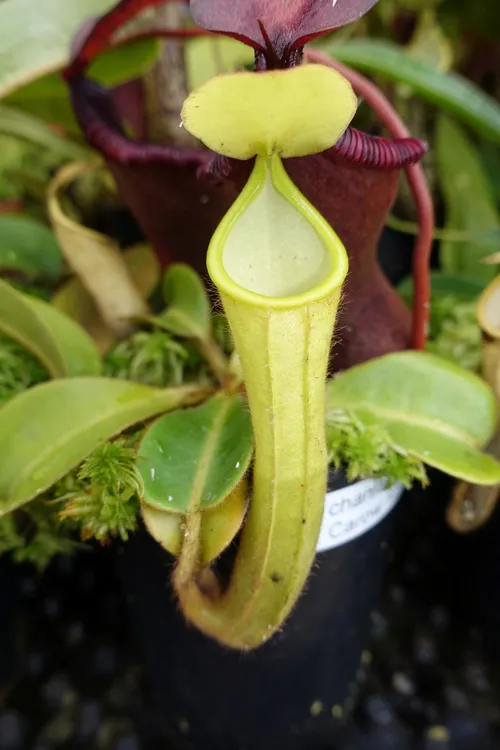 15. Nepenthes chaniana
15. Nepenthes chaniana 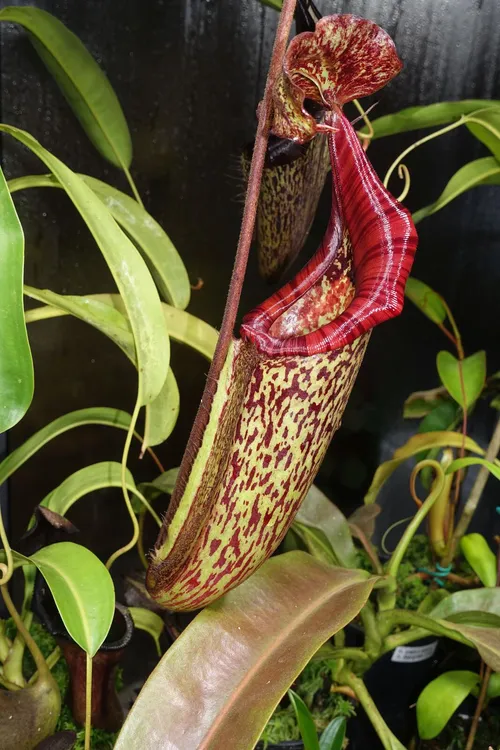 16. Nepenthes maxima
16. Nepenthes maxima .CKGeovGP_Kiay9.webp) 17. Two forms of N. maxima (right bought as N. eymae)
17. Two forms of N. maxima (right bought as N. eymae) 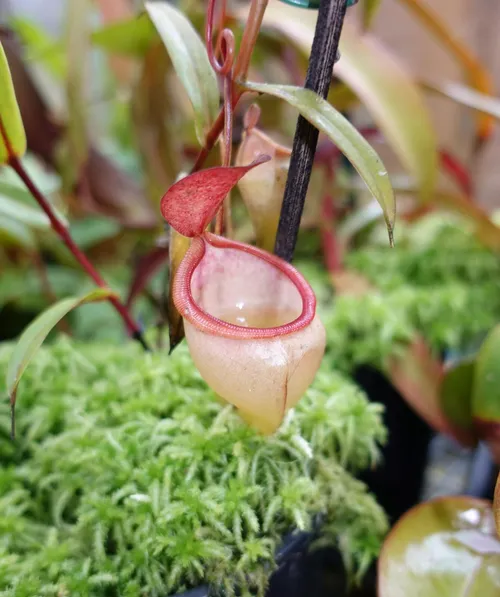 18. Nepenthes pitopangii
18. Nepenthes pitopangii 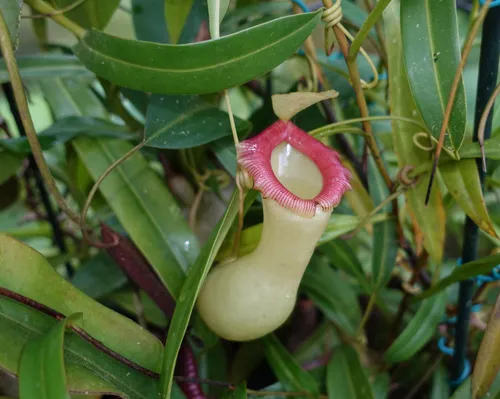 19. Nepenthes ventricosa
19. Nepenthes ventricosa 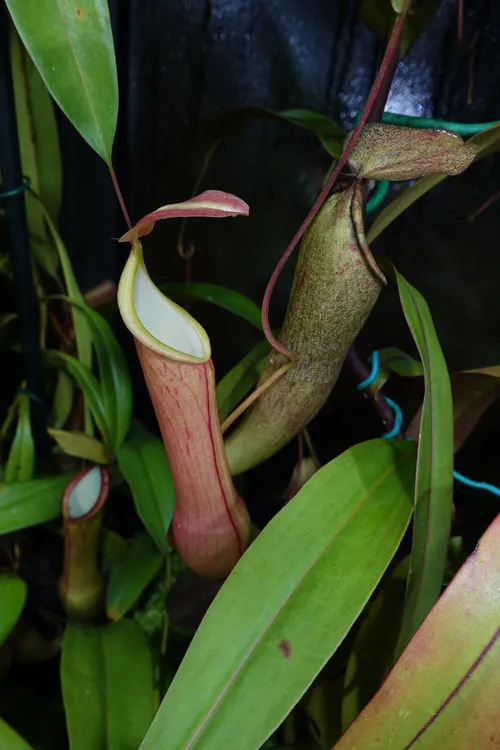 20. Nepenthes graciliflora
20. Nepenthes graciliflora 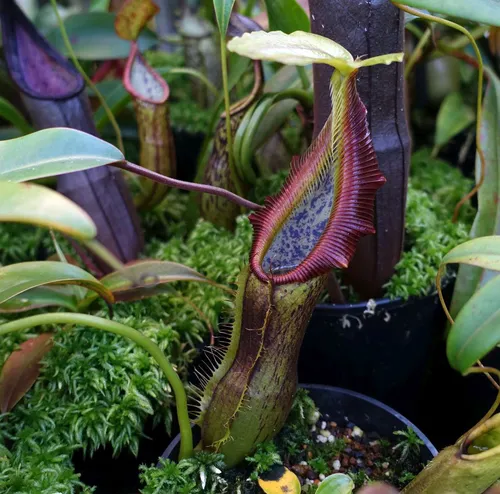 21. Nepenthes singalana Belriang
21. Nepenthes singalana Belriang 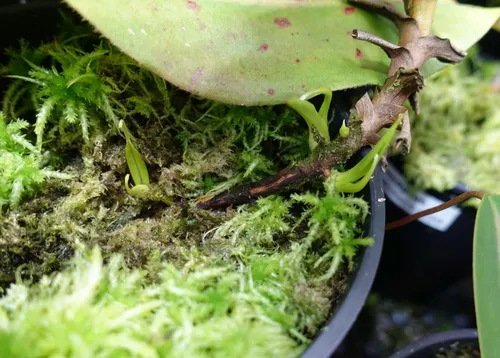 22. Four basals on the same N. singalana - stem cuttings soon!
22. Four basals on the same N. singalana - stem cuttings soon! 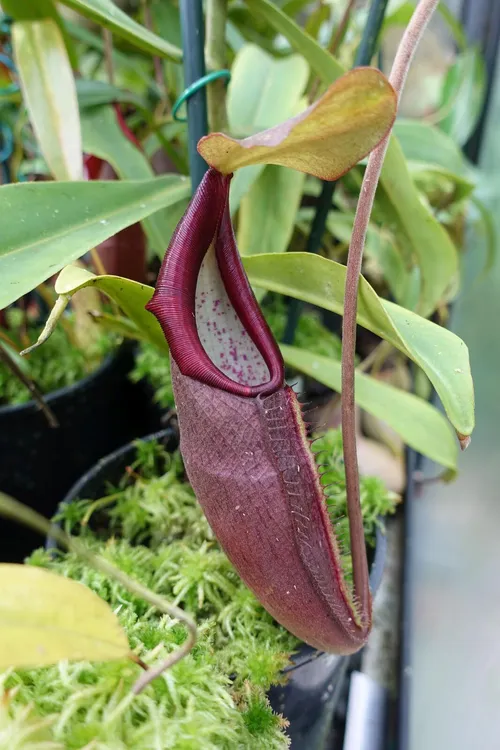 23. Nepenthes carunculata
23. Nepenthes carunculata 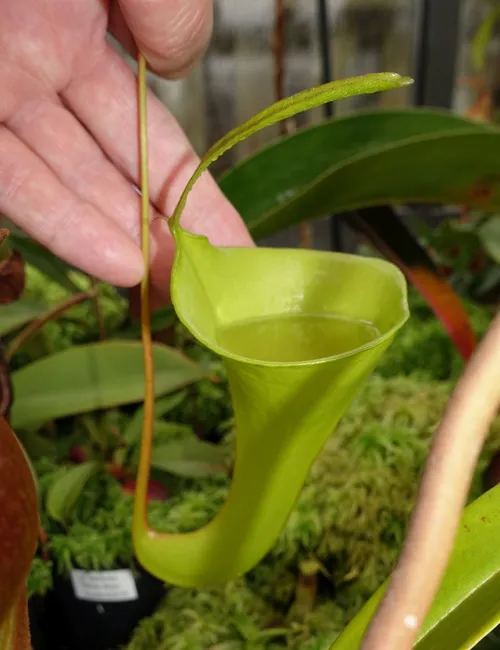 24. Nepenthes inermis
24. Nepenthes inermis .DRuXpxzK_ZidnWw.webp) 25. Nepenthes flava (AW)
25. Nepenthes flava (AW) 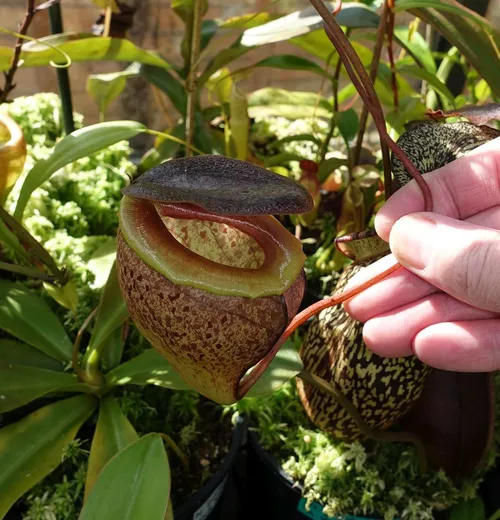 26. Nepenthes tenuis
26. Nepenthes tenuis 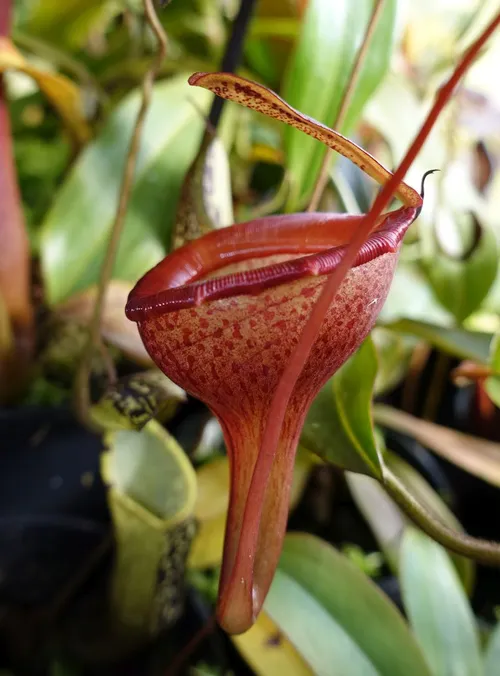 27. Nepenthes jamban
27. Nepenthes jamban 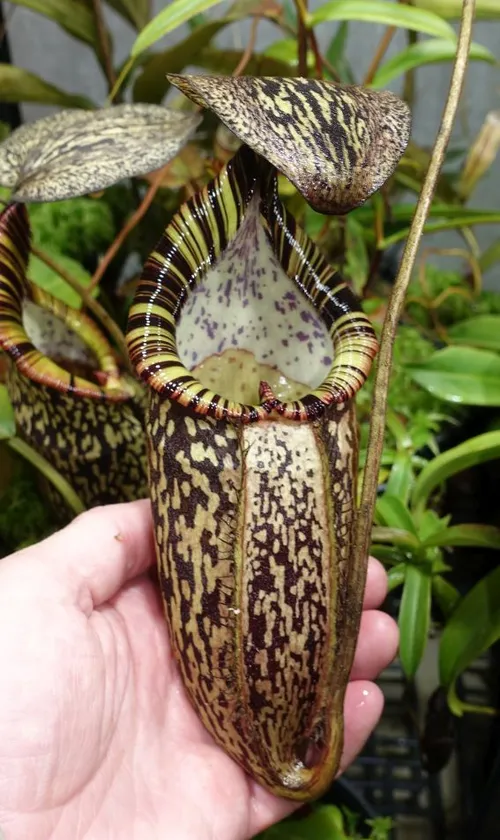 28. Nepenthes spectabilis Bandahara
28. Nepenthes spectabilis Bandahara 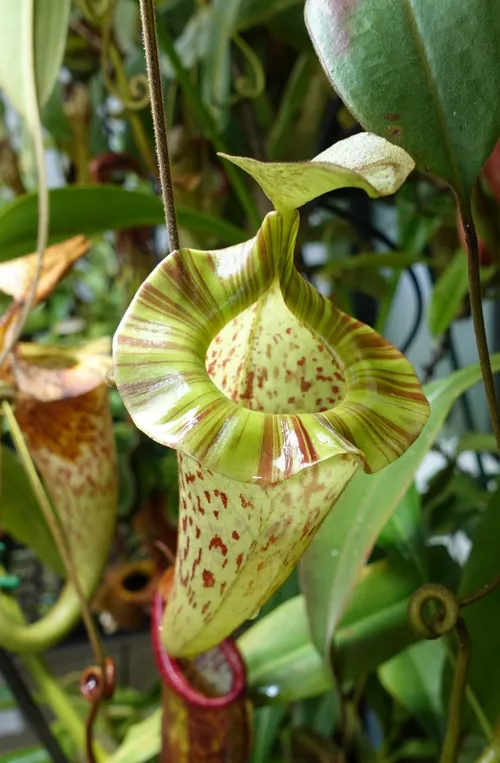 29. Nepenthes platychila
29. Nepenthes platychila 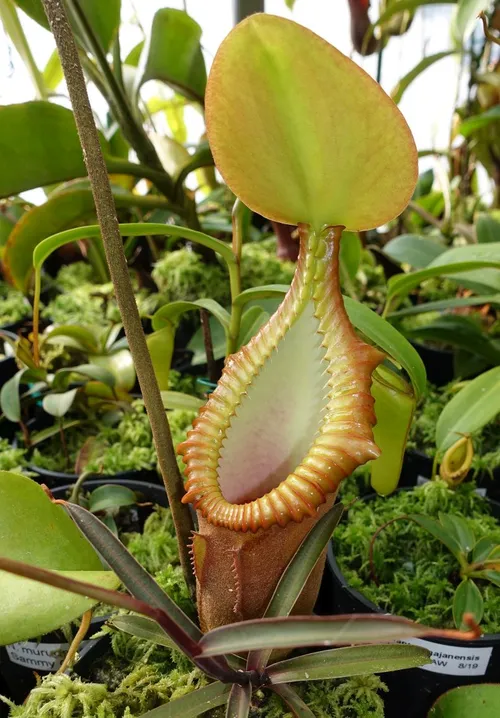 30. Nepenthes macrophylla
30. Nepenthes macrophylla .C0NKcDLj_1C9maI.webp) 31. Nepenthes reinwardtiana (red)
31. Nepenthes reinwardtiana (red) With the more complex hybrids I have difficulties in seeing the differences between them - and also remembering the names gets really tough. So I like pure species with distinctive features. Remembering names is also much easier when you have a tag with the plant’s name written on it. After bad experiences with different waterproof long-lasting label pens I now print these tags with a label maker. This is also an advantage for visitors and especially open days, when everyone can see what plant is in a pot without asking - and (me) feeling dumb having to look it up. 🙂
Do you have a go-to potting media for Nepenthes? And do you fertilize?
Growing Nepenthes for many years I of course have a special potting mix used for most plants in my collection: equal parts chopped live Sphagnum moss, peat, fine shredded cork pieces, lecaton (2-4mm burned clay for hydroponics), perlite, lava-rock and a hand full fine pumice stone per 10l of substrate (adding some minerals). Only some of the more fussy Nepenthes species which grow naturally in mossy forests are grown in pure live Sphagnum moss, which is used as topping on all pots and which I have in excess due to the available nutrients.
And yes, I fertilize all Nepenthes on a weekly basis by foliar feeding. A normal household liquid fertilizer at a lower concentration works well for me - I use Substral VitaPlus Pflanzennahrung. At about a quarter of its recommended concentration I apply to all Nepenthes with a watering can from overhead. This fertilizer is designed for tap water, but I’m using rainwater collected from the greenhouse roof, so with this fertilization calcium and magnesium are missing - the plants are therefore supplemented with these once a month. I overdid it in the beginning and lost all my N. stenophylla seedlings, which went black from the base - but no other plant was lost. The larger plants did not show any negative signs of this treatment.
I saw on the forum you’ve flowered many of your plants to produce your own crosses. Are there specific kinds of crosses you like making? Do you have any goals for species you’d love to flower and cross one day?
Growing larger Nepenthes, at any one time there are always some plants in flower. Pollination is easy, but what to do with the massive amount of seeds which will develop?
This year my female N. boschiana x clipeata flowered and I requested pollen donors at the GFP-forum. In the end I received fourteen different pollen donations and had some work to do… Half of the harvested seeds are of course given to the pollen donors and I am sharing my half of the seeds with three of the commercial growers I know well, if they are interested.
Click on any photo to zoom in. Use arrow keys or swipe to navigate.
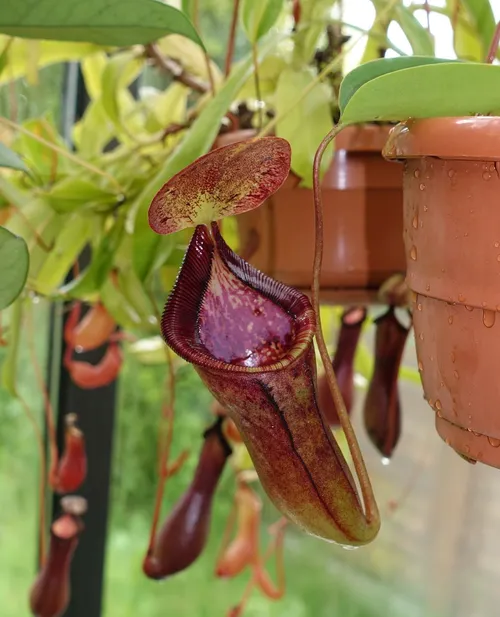 01. Nepenthes lowii x campanulata
01. Nepenthes lowii x campanulata 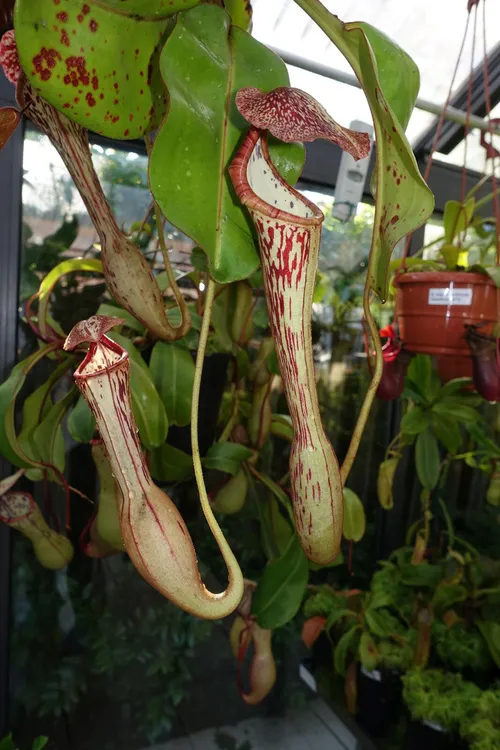 02. Nepenthes boschiana x clipeata
02. Nepenthes boschiana x clipeata 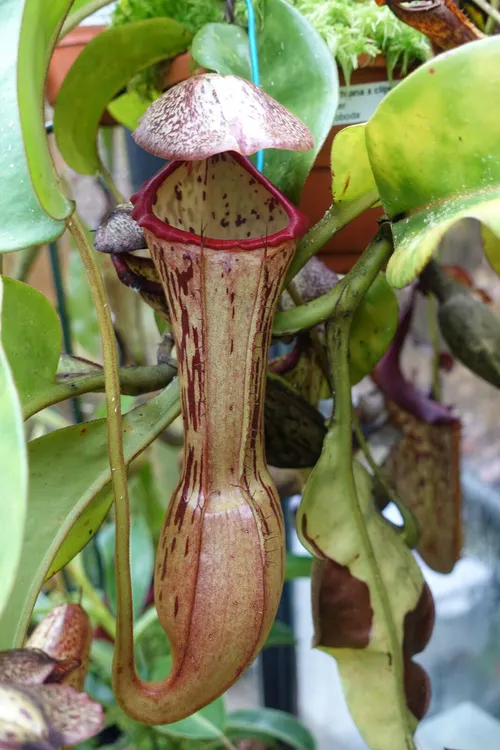 03. Nepenthes boschiana x clipeata
03. Nepenthes boschiana x clipeata 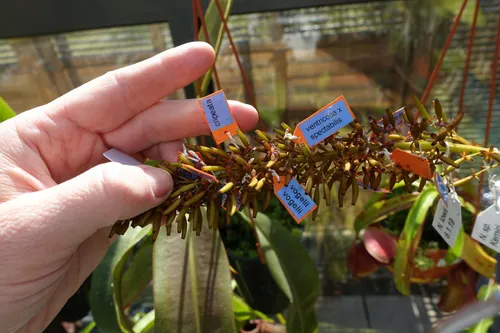 04. Seeds developing on Joachim's N. boschiana x clipeata
04. Seeds developing on Joachim's N. boschiana x clipeata 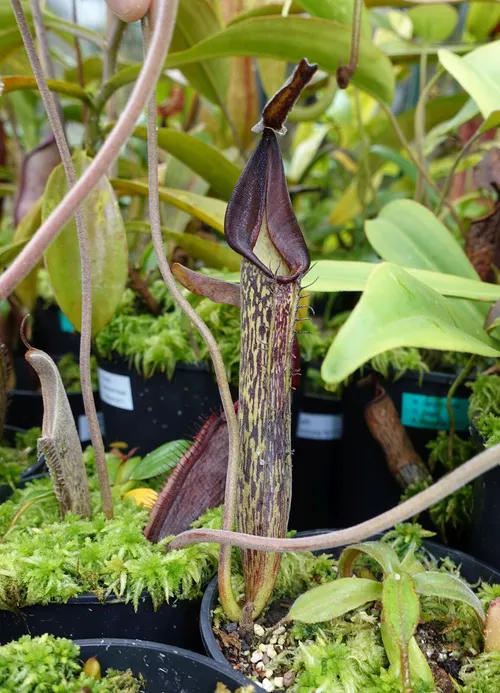 05. Nepenthes zakariana
05. Nepenthes zakariana 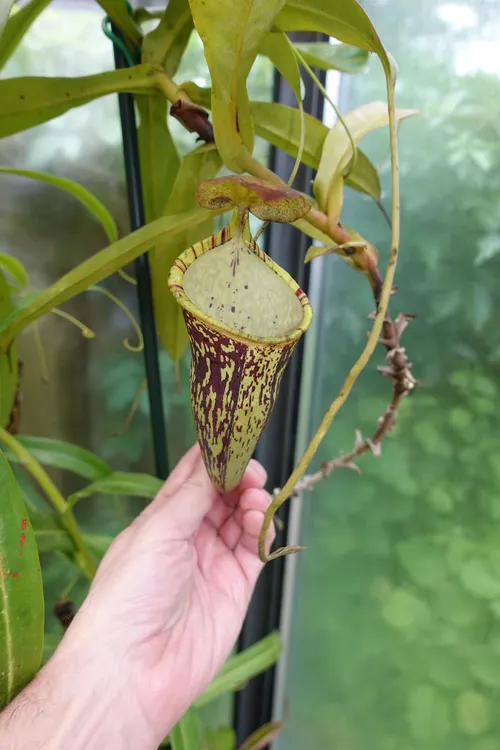 06. Nepenthes campanulata x spectabilis
06. Nepenthes campanulata x spectabilis 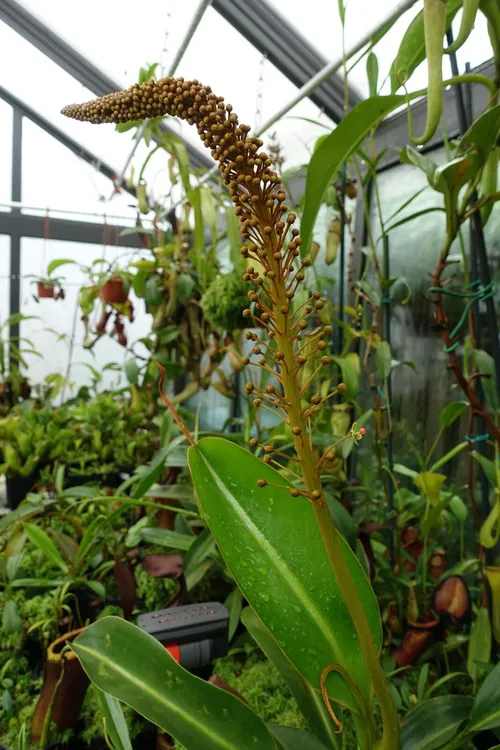 07. Nepenthes x Trusmadiensis inflorescence
07. Nepenthes x Trusmadiensis inflorescence 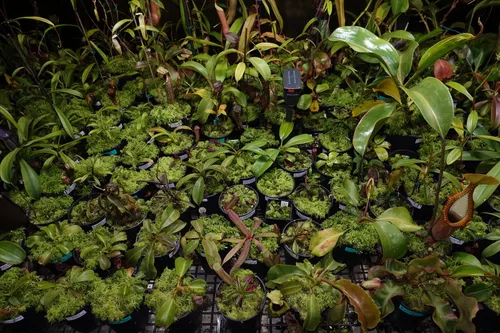 08. Nepenthes seedlings
08. Nepenthes seedlings 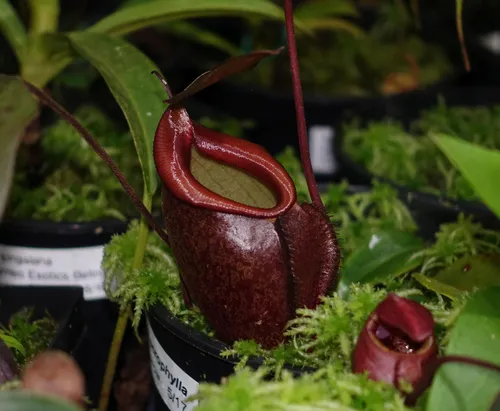 09. A hybrid bought as N. jacquelineae
09. A hybrid bought as N. jacquelineae 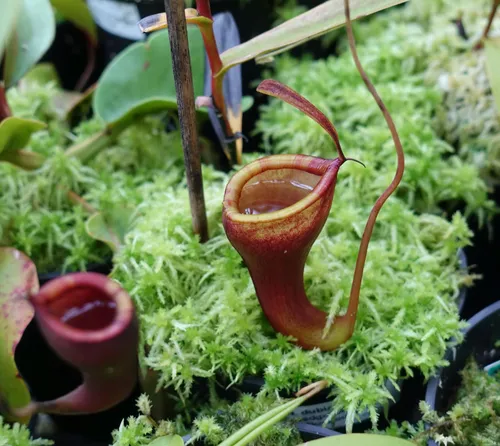 10. Nepenthes dubia x jamban
10. Nepenthes dubia x jamban 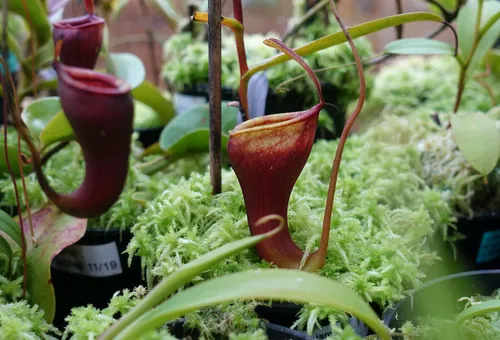 11. Nepenthes dubia x jamban
11. Nepenthes dubia x jamban 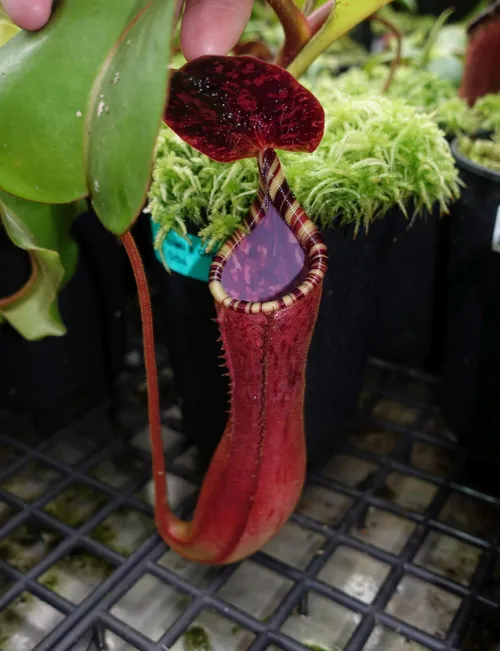 12. Nepenthes lowii x clipeata
12. Nepenthes lowii x clipeata 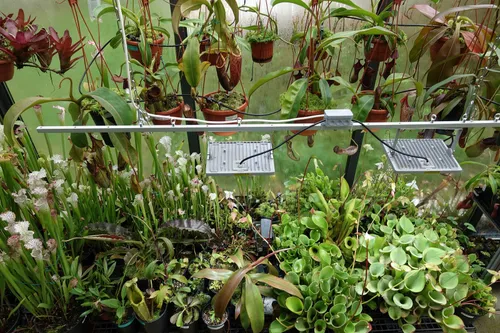 13. Various genera
13. Various genera 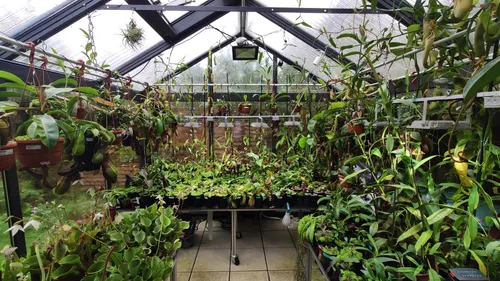 14. The jungle!
14. The jungle! Some crosses I make I don’t even keep seed for myself, as others are more successful in growing small seedlings to maturity. So the rest of the seed is often given to those who reply first to my offer at the GFP-Forum.
Right now N. minima x minima, N. minima x boschiana, N. singalana x spathulata and N. singalana x boschiana seeds are ripening. My goal is to make pure species seed, so the N. minima x minima seeds are the only really interesting ones for me. I am also hoping that the N. tobaica which I have coming into flower right now will be male, so I can pollinate the female N. tobaica which opened its first flowers several days ago. N. tobaica is not the most sought-after species, but it is a nice species which grows very well and has interesting upper pitchers.
Do you grow many plants propagated by tissue culture?
I love plants from tissue culture! You can get very nice plants for reasonable prices and if a disaster happens you can easily get an identical plant and start over. More than one identical plant makes optimizing your growing conditions quite easy. I really can’t understand the enthusiasm for “seed grown” plants, knowing that as a beginner in this hobby you have to experiment a lot and some of your plants won’t survive for a long time (my experience).
It’s also important to remember that seeds of rarer species are quite often collected from nature and don’t originate from cultivated plants.
Speaking of wild-collected seed, do you think tissue culture has a big role to play in protecting these plants in the wild? And what are some of the ways in which the CP community can help fight poaching?
When I started the hobby about 80 Nepenthes species were known, and one of the plants which was immediately of great interest to me was the diminutive N. tenuis, after seeing the single known picture of this species in the “Nepenthes of Sumatara and Peninsular Malaysia” book by Charles Clarke released in 2001 (a must have!).
A year later, N. tenuis was rediscovered. This single expedition was enough to get the species safely into cultivation, and only a short time later it was widely available from private growers and commercial nurseries. There’s now less pressure to collect seeds, cuttings, and complete plants from wild habitats as this species is more easily available for little money.
Sadly this does not work as well for the very slow growing and difficult to propagate species like N. edwardsiana or N. villosa. It makes me very sad seeing large plants for sale which are obviously cuttings or whole plants taken from the wild.
It might be tempting to buy poached plants, but knowing that we growers - by loving these plants and wanting them in our collections - are the root cause for many species declining in nature, it’s our responsibility to be ethical. This means taking an active interest in plant provenance and never buying poached plants. Speaking about this problem with other growers, and sharpening their view on where offered plants originate from, is the next key to protecting nature for me. And as I own some rare and desirable Nepenthes, I am trying to propagate them by giving cuttings or seeds to other growers who can grow them successfully, further reducing pressure on the natural world.
A great way to protect plants in nature is by buying from the reliable commercial nurseries. Thanks to tissue culture, a few seeds can be enough to produce many thousands of plants for cultivation, fulfilling the increasing demands of growers. Mass availability and reasonable prices really are the best way to protect the plants we love.
Any particular upcoming releases you are excited about?
I am really excited about N. undulatifolia (as of fall 2020). It was first described in 2011, and in 2013 I saw the first plant in cultivation. Of course I was fascinated and eager to get such a nice plant for myself! From time to time cuttings are sold through Facebook or eBay - for astonishing prices, not in my range.
Patience finally is the key to success: in August 2020, Andreas Wistuba showed the first N. undulatifolia seedlings grown from horticulturally-produced seeds and announced that this species will be available from his nursery soon. The seedling in my collection shown below is from the same grex. Andreas told me that he plans to put a very reasonable price tag on these plants, and I’m happy that more than the six plants shown will be available, making this rare species available to more growers.
Click on any photo to zoom in. Use arrow keys or swipe to navigate.
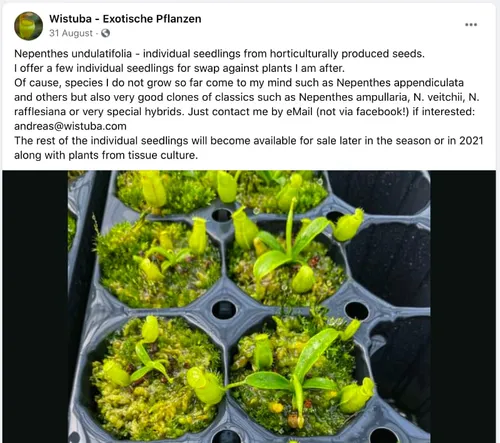 Nepenthes undulatifolia, soon to be available from Wistuba
Nepenthes undulatifolia, soon to be available from Wistuba 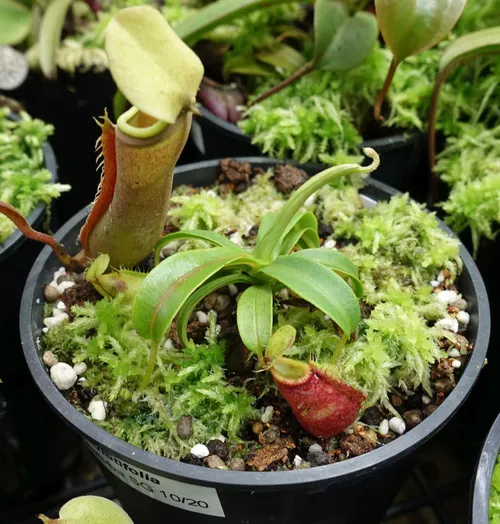 Nepenthes undulatifolia
Nepenthes undulatifolia Finally, could you share a couple of your favorite specimens, and the story behind them?
Well, in fact I have a lot favorite Nepenthes - it is difficult to pick some out of them! Personally I like nice forms and colors, size is not a major factor for me - although everyone looks first at my big N. x Trusmadiensis with its large pitchers and the large flower stem it had last year, reaching about one meter in length. I got this male plant as small cutting about eight years ago and I am very happy it survived the terrarium times and then really took off in the greenhouse.
Click on any photo to zoom in. Use arrow keys or swipe to navigate.
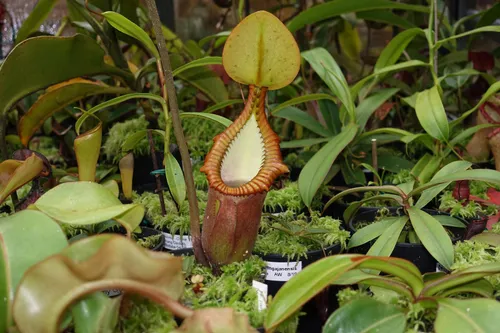 Nepenthes macrophylla
Nepenthes macrophylla 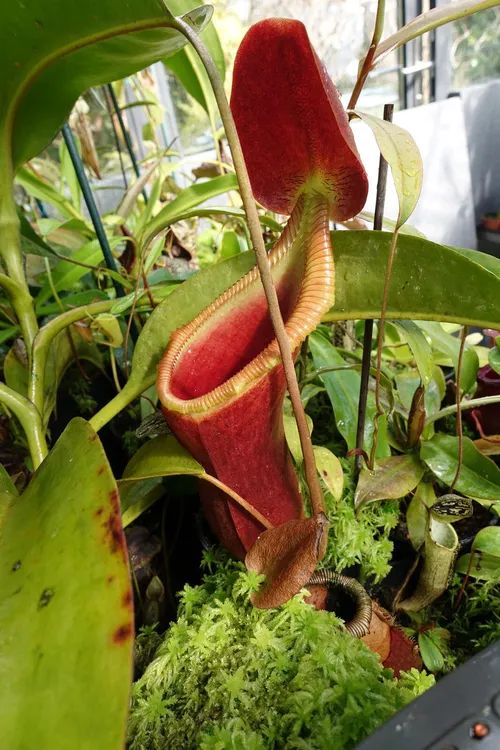 Nepenthes x Trusmadiensis
Nepenthes x Trusmadiensis Among my larger plants, N. macrophylla is the next eye-catcher with its orange colored pitchers. I got it only a year ago, and I think every time I’m taking photos in the greenhouse I end up having a new N. macrophylla shot - although the plant grows extremely slowly and the pitcher always looks the same. It must be one of my favorites! 🙂
Looking through my list I have to admit that N. glabrata must also be one of my favorites with seven different clones under my care. The largest plant started to climb last year and makes unbelievable upper pitchers which are up to 15cm in height, compared to the diminutive lower ones. I like these smaller species, because they don’t need much space on the tables.
N. tenuis, N. flava, N. dubia and N. jacquelineae also fall in this range being special for me. They have very distinctive pitchers and especially the uppers are a great sight. Maybe this is due to my long history with terrariums that were always too small - I was happy when the plants produced adult pitchers at a small size.
Click on any photo to zoom in. Use arrow keys or swipe to navigate.
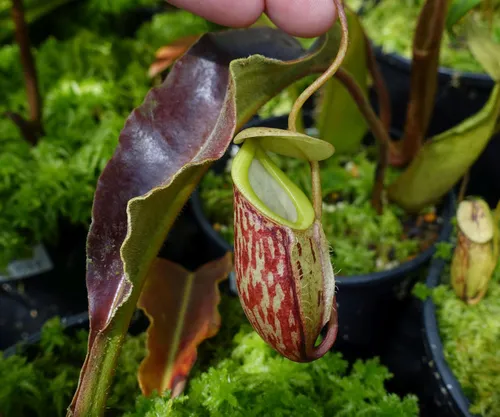 01. Nepenthes glabrata
01. Nepenthes glabrata 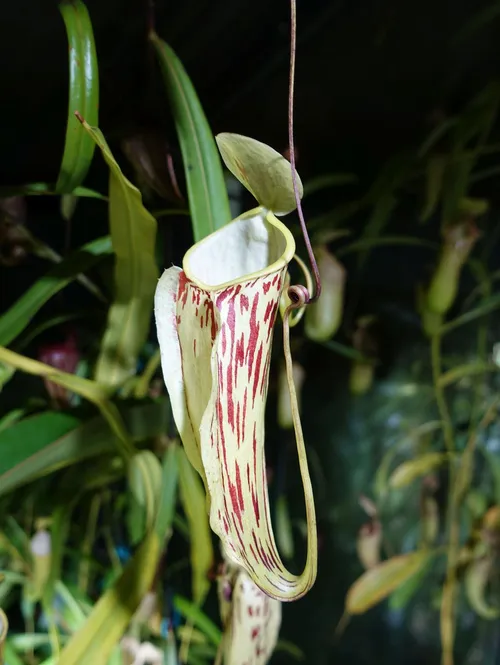 02. Nepenthes glabrata upper, about 15cm tall
02. Nepenthes glabrata upper, about 15cm tall 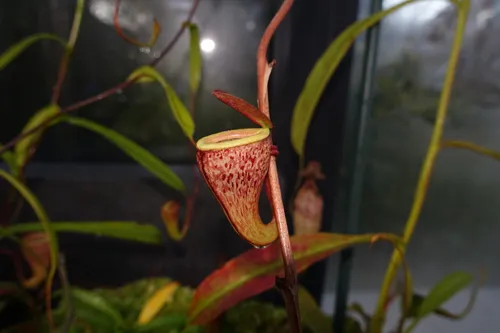 03. Nepenthes tenuis
03. Nepenthes tenuis 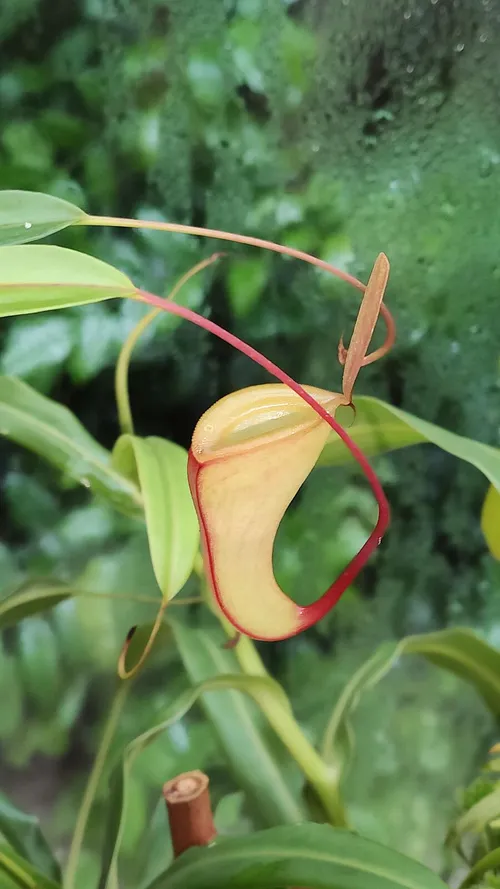 04. Nepenthes dubia from Talamau
04. Nepenthes dubia from Talamau Another favorite is N. inermis with those very unusual upper pitchers - they are not very long-lasting, but have this beautiful shape without a peristome and this viscous sticky fluid. Pitchers are up to 12cm in size, and once it starts to climb this species grows quite fast - my plant has also developed some sideshoots. It has not flowered yet, but according to Miroslav, who took a cutting, it is a male plant. Being able to sex a plant is another great development from the last years! With limited growth space it is important that two plants of one species are enough to get a pair for producing pure seeds one day.
Another fast climber is N. dubia - my larger plant I got in 2017 has reached the ceiling and flowered twice. It has about nine growing points, but rarely produces pitchers - the shading of 80% to keep temperatures down in summer seems a bit too much for it, scrambling over the top of the vegetation in nature.
Of course there are also some hybrids I really like. Best example is the cross N. ventricosa x lowii which Johannes Marabini made many years ago. It has those long-lasting N. lowii-shaped pitchers and grows quite well. The reverse cross was remade by Borneo Exotics and now this hybrid is widely available in local garden centers here in Europe. A really perfect beginners plant with very showy pitchers at a more than reasonable price!
Click on any photo to zoom in. Use arrow keys or swipe to navigate.
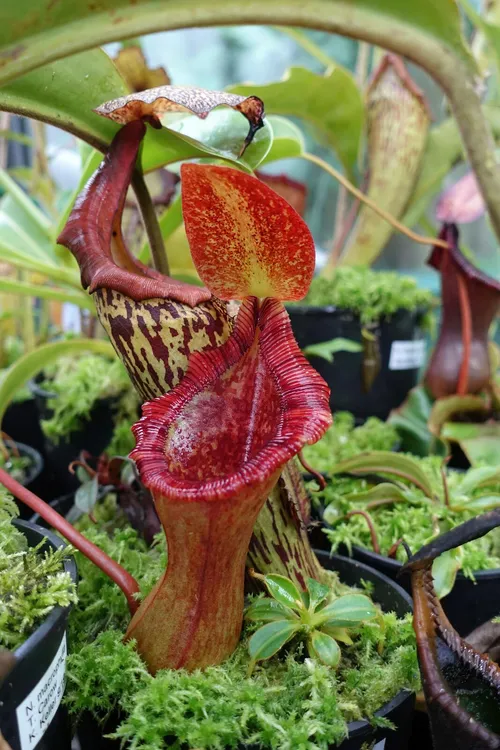 Nepenthes lowii x ventricosa
Nepenthes lowii x ventricosa 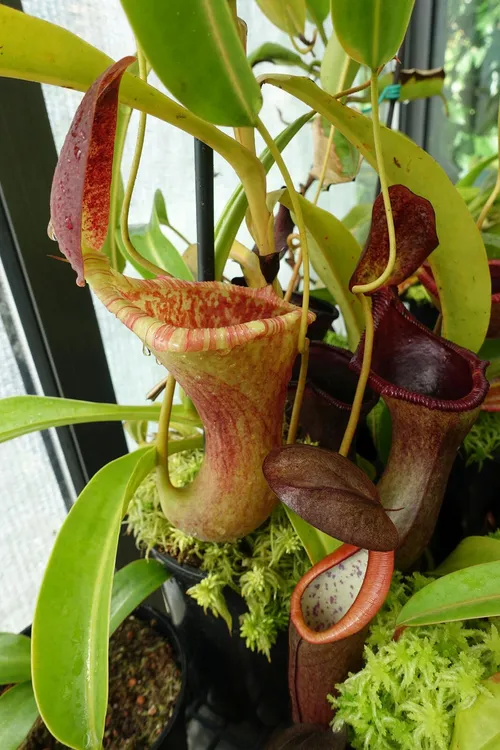 Nepenthes x Briggsiana
Nepenthes x Briggsiana Many thanks to Joachim for taking the time to speak with me and for sharing photos of his wonderful collection.
